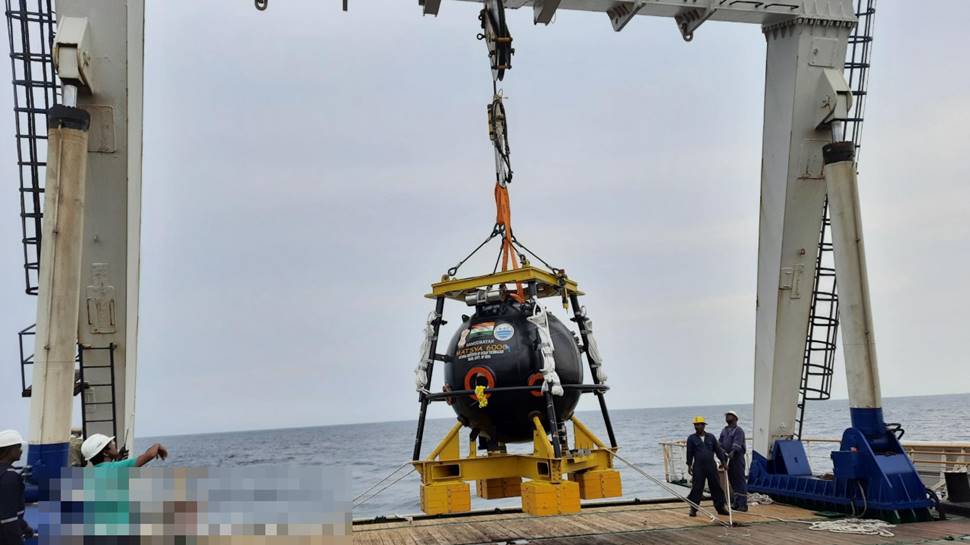India's Samudrayaan Project is the country's first human-crewed deep ocean mission. It is part of the Deep Ocean Mission launched by the Ministry of Earth Sciences (MoES). The goal is to explore the deep sea and unlock its hidden resources.
Scientists plan to send three people in a special submersible called MATSYA 6000 to a depth of 6,000 metres. This vehicle is being developed by the National Institute of Ocean Technology (NIOT) in Chennai.
The mission will study minerals, metals, and marine biodiversity. It will also help India tap into the blue economy, which encompasses ocean-based industries such as fishing, mining, and tourism. India has been allocated a 75,000 sq. km area in the Central Indian Ocean Basin for the exploration of polymetallic nodules.
These contain valuable metals like copper, cobalt, and nickel. Samudrayaan will help India become a global leader in ocean research and sustainable resource use.
What is the Samudryaan Project?
The Samudrayaan Project is India's first-ever human-crewed deep-sea mission. The primary objective is to deploy three individuals in a specialised submersible vehicle, the MATSYA 6000, to a depth of 6,000 metres (approximately 3.7 miles) in the ocean. This is part of a bigger initiative known as the Deep Ocean Mission.
The MATSYA 6000 is a sphere-shaped vessel that can protect its occupants from the immense pressure found at great depths underwater. It's built to operate for 12 hours under normal conditions and up to 96 hours in an emergency.
The mission's purpose is not just to prove India's technological capability. Scientists will use the submersible to study the ocean's depths, including marine life and valuable non-living resources, such as minerals (for example, polymetallic manganese nodules), which could be necessary for the country's economy.
The project aims to boost India's "Blue Economy" and place it in an exclusive group of countries utilising this advanced deep-sea exploration technology.
Which Year Will India Launch Samudrayaan?
)
The Samudrayaan mission is scheduled to be launched by the end of 2026. Officials have mentioned this timeline, which is part of the larger Deep Ocean Mission, running from 2021 to 2026.
The project is a phased process, with various tests and trials of the submersible, the MATSYA 6000, being conducted over the next couple of years before the final manned deep-sea exploration.
The successful completion of these tests will pave the way for India to join an exclusive group of countries with this deep-sea technology.
What are the Key Objectives of the Samudrayaan Project?
The Samudrayaan Project is an exciting new mission for India's deep ocean exploration. It is a part of the larger Deep Ocean Mission and aims to develop a special submersible vehicle to explore the deep sea. Here are the key objectives of the Samudrayaan Project:
- To Develop a Manned Submersible: The primary goal is to design and build a vehicle called MATSYA 6000 that can safely transport three people to a depth of 6,000 meters (approximately 3.7 miles) in the ocean. This is the first time India has built a vehicle capable of taking humans so deep.
- To Explore Mineral Resources: The mission will search the deep ocean floor for valuable minerals, such as polymetallic manganese nodules, which are rich in metals like manganese, nickel, and cobalt. These resources are vital for electronics and batteries.
- To Study Deep-Sea Life: The project will enable scientists to study the strange and unique plants and animals that inhabit the deep ocean, where sunlight is unable to reach. It will help us learn more about marine biodiversity and how we can protect it.
- To Advance Technology: Samudrayaan is a huge technological challenge. Building a vehicle that can withstand the incredible pressure at 6,000 meters will help India develop new, indigenous technology for deep-sea engineering and other scientific applications.
- To Support the Blue Economy: The project is a key part of India's "Blue Economy" policy. This means utilising the ocean in a thoughtful, sustainable manner for economic growth, encompassing activities such as fishing, tourism, and the exploitation of marine resources. This mission will help India become a global leader in ocean science and technology.
What Technology Is Used in Building the MATSYA 6000?

The MATSYA 6000 submersible is a technological marvel designed to withstand the crushing pressure of the deep sea. The key to its success lies in several advanced technologies, many of which were developed right here in India.
Here are some of the main technologies used in the MATSYA 6000:
- Titanium Alloy Hull: The most crucial part of the submersible is its robust outer shell, known as a "personnel sphere," which protects the three people inside. It's made from a special titanium alloy that can handle pressure more than 600 times greater than what we experience at sea level.
- The Indian Space Research Organisation (ISRO) played a pivotal role in establishing this sphere, showcasing the collaboration between various parts of India's science and technology community.
- Buoyancy and Thrusters: To go up and down and move around, the submersible uses a ballast system (which adds or removes water to control its weight) and special thrusters (like underwater propellers) that allow it to move in any direction.
- Life Support Systems: For the crew to survive, the submersible has a Human Support and Safety System (HSSS). This system maintains fresh air by providing oxygen and removing carbon dioxide. It is designed to sustain the crew for up to 12 hours during a mission, with an emergency supply that can last for 96 hours.
- Navigation and Communication: Since sunlight and radio waves cannot penetrate deeply, the MATSYA 6000 utilises a specialised acoustic positioning system to communicate with the mothership on the surface. It also has robotic arms for collecting samples from the seafloor and high-resolution cameras to capture images of deep-sea life and minerals.
Comments
All Comments (0)
Join the conversation